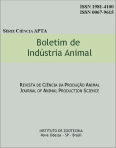Fertility limitations of a Dark Red Latosol for macrotiloma growth
Keywords:
macrotiloma, mineral nutrition, phosphorus, lime, manganese, zincAbstract
This experiment was conducted with the objective of identifying the main nutrient deficiencies that can limit the growth and nitrogen fixation of macrotiloma (Macrotyloina axiliare (E. Mey) Verdc). The legume was grown in a Dark Red Latosol from Itapetininga located in the South Region of São Paulo State, Brazil. The study was done in a greenhouse at the Instituto de Zootecnia, in Nova Odessa, State of São Paulo, from October 1984 to March 1985. Ten treatments were arranged in a randomized complete block design with four replications. An omisson type of treatment arrangement allowed to study the effects of lime, P, K, S, Cu, Mn, Zn and Mo. The results showed that: a) phosphorus deficiency was the most limiting factor for legume establishment, growth and nitrogen fixation; b) lime omission reduced significantly (P < 0.05) the dry matter yield, the total amount of nitrogen and nodulation; c) manganese concentration in the herbage was very high iii the treatments without lime application; d) zinc omission resulted significant decrease (P < 0.05) in the concentration of this micronutrient in the herbage; e) the omissions of K, S, Cu and Mo did not change significantly (P > 0.05) any of the studied variables.Downloads
Downloads
Published
Issue
Section
License
Os autores não serão remunerados pela publicação de trabalhos, pois devem abrir mão de seus direitos autorais em favor deste periódico. Por outro lado, os autores ficam autorizados a publicar seus artigos, simultaneamente, em repositórios da instituição de sua origem, desde que citada a fonte da publicação original seja Boletim de Indústria Animal. A revista se reserva o direito de efetuar, nos originais, alterações de ordem normativa, ortográfica e gramatical, com vistas a manter o padrão culto da língua e a credibilidade do veículo. Respeitará, no entanto, o estilo de escrever dos autores. Alterações, correções ou sugestões de ordem conceitual serão encaminhadas aos autores, quando necessário. Nesses casos, os artigos, depois de adequados, deverão ser submetidos a nova apreciação. As opiniões emitidas pelos autores dos artigos são de sua exclusiva responsabilidade. Todo o conteúdo deste periódico, exceto onde está identificado, está licenciado sob a Licença Creative Commons Attribution (CC-BY-NC). A condição BY implica que os licenciados podem copiar, distribuir, exibir e executar a obra e fazer trabalhos derivados com base em que só se dão o autor ou licenciante os créditos na forma especificada por estes. A cláusula NC significa que os licenciados podem copiar, distribuir, exibir e executar a obra e fazer trabalhos derivados com base apenas para fins não comerciais.













